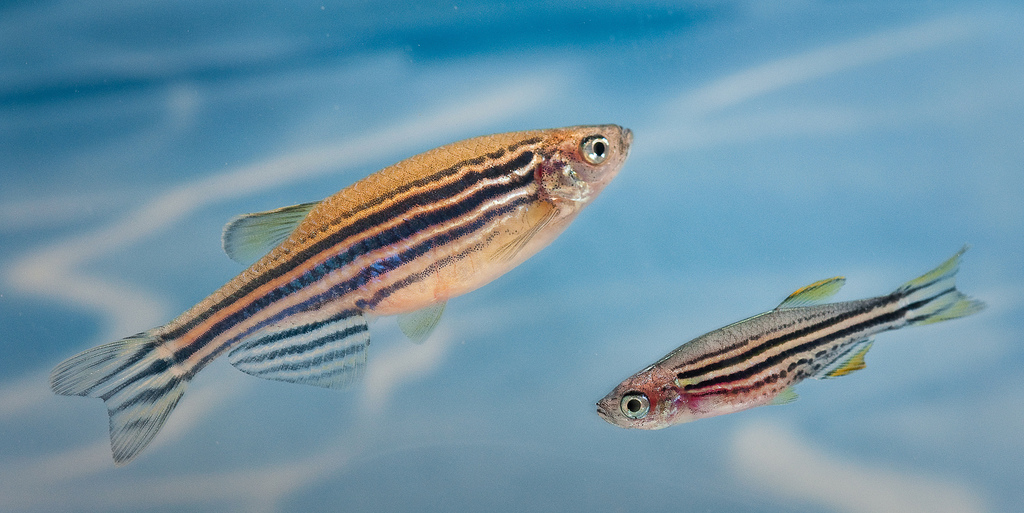 Evolution & Behaviour
Evolution & Behaviour
Swimming Against the Flow
Is your train moving or the one outside of your window-train? A tiny fish like zebrafish would be able to tell the difference in the blink of a...fin!

A fundamental and often neglected feature of life on Earth is that all organisms live immersed in fluids. In the case of animals that fly or swim, locomotion is, therefore, a combination of their own movement and the displacements of the surrounding air or water. For example, a fish within a current needs to actively swim against the oncoming water flow in order to avoid potentially dangerous areas downstream. This behavior, known as rheotaxis, has been largely described as a response of the fish to the visual perception of its own drift.
In principle, this visual explanation makes a lot of sense. If you are sitting on a train that starts to move, the landscape outside the window will start to pass in front of your eyes and, as a result, you will know the train is moving. However, numerous aquatic animals that live in very low light conditions, in extremely turbid waters or that naturally have no eyes perform rheotaxis with no apparent problems. This poses a major conceptual problem: in the absence of visual cues (for example, if the train windows were closed), your frame of reference would be the interior of the train, and as you and the train would move at the same speed there would be no way for you to know that the train is moving. The same would happen in the case of fish. In the dark, the frame of reference of the animal would be the flow of water in which it is immersed, and since both water and animal move at the same speed, it would be physically impossible for the fish to perceive the current. So, our initial question was quite simple: how do they do that? To answer this question, we built a setup in which we could induce an artificial water flow while recording the behavioral response of an aquatic animal amenable for laboratory work, the larval zebrafish. We observed that, in the absence of visual frames of reference, larval zebrafish performs rheotaxis by using its lateral line system (a set of mechano-sensitive organs located all over the surface of the fish) to 'read' velocity gradients in the flow. These velocity gradients are the product of the contact between a fluid and a static surface such as the bank of a river or a rock. At this contact points, the water molecules closest to the static surface tend to adhere to it and, as a result, slow down. At the same time, these molecules adhere to their neighboring molecules and also slow them down, generating a gradient of velocities in which the flow moves more slowly the closer it is to a static surface. This means that, for example, in a river the flow of water is very slow near the banks and very fast near the center.
Interestingly, these velocity gradients will tend to rotate any object, such as the body of a larval zebrafish, immersed in them. If for example the head of the fish is near the left bank of the river (where flow velocity is low) and the tail is closer to the center (where flow velocity is higher), the gradient will generate a rotational flow field that will eventually rotate the fish body in a clockwise direction. Based on these observations, our analyses allowed us to describe a simple set of rules, or algorithm, by which larval zebrafish perform rheotaxis. This behavioral algorithm indicates that if the fish moves from an area of high to an area of low gradient magnitude (i.e., swim from the shore towards the center of the river), the animal simply continues swimming in the same direction. On the other hand, if it moves from an area of low to an area of high gradient magnitude (i.e., swim from the center of the river towards the shore), the fish executes a strong turn in the direction of the rotational flow field around its body.
This behavioral algorithm not only helps explain how a particular fish performs a particular behavior, but also provides the opportunity to build a predictive model of how the brain generates behavior (a fundamental step in the analysis of brain recordings) and opens the possibility of designing aerial and/or aquatic drones that can navigate, in the absence of visual cues, through buildings, respiratory tracts, pipes and/or blood vessels.
Original Article:
Oteiza P, Odstrcil I, Lauder G, Portugues R, Engert F. A novel mechanism for mechanosensory-based rheotaxis in larval zebrafish. Nature. 2017;547(7664):445-448. doi:10.1038/nature23014.Next read: How nanosized shrapnel from exploding fungal cells may impact us: from allergies to cloud formation by Michael J. Lawler
Edited by:
Massimo Caine , Founder and Director
We thought you might like
Visualizing the effects of sleep on neurons’ maintenance
Oct 11, 2019 in Neurobiology | 3 min read by David Zada , Lior AppelbaumMore from Evolution & Behaviour
Cicada emergence alters forest food webs
Jan 31, 2025 in Evolution & Behaviour | 3.5 min read by Martha Weiss , John LillSize does not matter: direct estimations of mutation rates in baleen whales
Jan 29, 2025 in Evolution & Behaviour | 4 min read by Marcos Suárez-MenéndezThe Claws and the Spear: New Evidence of Neanderthal-Cave Lion Interactions
Jan 22, 2025 in Evolution & Behaviour | 3.5 min read by Gabriele RussoA deep-sea spa: the key to the pearl octopus’ success
Jan 20, 2025 in Evolution & Behaviour | 3.5 min read by Jim BarryFeisty fish and birds with attitude: Why does evolution not lead to identical individuals?
Aug 31, 2024 in Evolution & Behaviour | 3 min read by Lukas Eigentler , Klaus Reinhold , David KikuchiEditor's picks
Trending now
Popular topics


